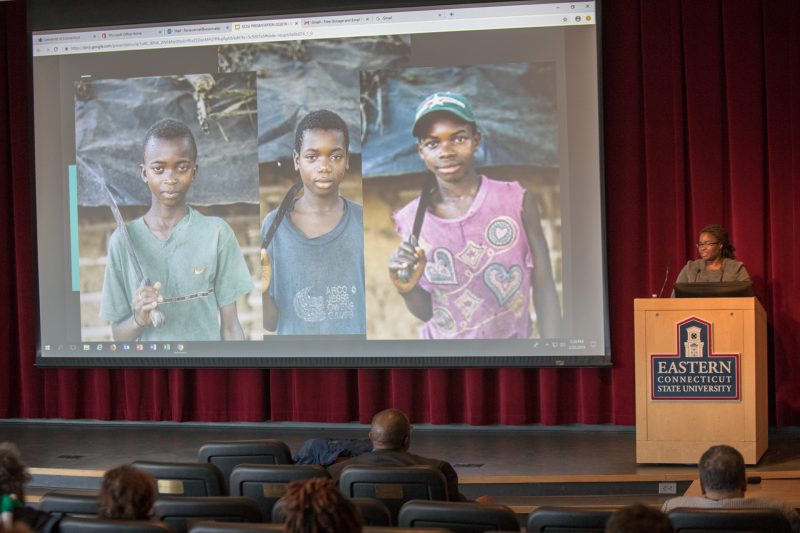


Published on March 20, 2019

Despite its popularity, chocolate is a treat that comes with a greater cost than most people know. Fiona Vernal, professor at the University of Connecticut, was invited to Eastern Connecticut State University on March 20 to explain the prevalence of child labor in the cocoa industry and the emergence of child labor as a major human rights crisis.
Before her presentation, Vernal surveyed audience members to determine their favorite kinds of chocolate. With Snickers and Kit Kats among the most common responses, she used the audience’s favorite brands to highlight the blissful consumerism surrounding the business. “Child labor has always been a part of the cocoa industry,” she said, but only recently has it been identified as a crisis.
Vernal shared photographs throughout the lecture that depict the reality of child labor in many African cocoa farms. She began by discussing the role of the “typical African farm” in the mass production of chocolate. Since the 19th century, in order to survive, these farms must use familial labor to make up for lack of significant income. She addressed the looming “farm gate price,” which is crop profit minus extra expenses. According to Vernal, with low access to resources, high input prices and small-scale farms, African farmers have been historically disadvantaged.
She revealed that the majority of cocoa comes from Ivory Coast, Ghana, Indonesia, Cameroon and Nigeria. With 60-70 percent of Africans participating in agriculture, there has been growth in the farm gate price over the years, but there is still persistent poverty. When a chocolate bar is sold, only three percent of the revenue goes back to the farmer. “The story that I’m telling is not that different from other commodities across African colonial history,” said Vernal.
She went on to describe the nature of the crisis behind cocoa farming, noting that child laborers are exposed to harmful pesticides, required to use dangerous tools such as machetes and engage in heavy lifting beyond their capabilities. Moreover, protective gear and clothing is rarely available. Some of these children are as young as five years old.
There is very little concern about assisting farm families, Vernal stated. Reasons vary, but include not wanting to interfere in African affairs. While those who remain uninvolved argue in favor of autonomy, Vernal pointed out that this mindset is another means of avoiding a serious set of problems. In the name of being hands-off, companies allow families to go without earning enough money, resulting in child labor. “They simply provide a market for that product.”
Human rights activists have long fought to change the chocolate business, though companies are still slow to make changes. “Cocoa production has been labeled as using the worst forms of child labor,” said Vernal, “and that language is important.” Upward of 1.8 million children between ages five and 17 are involved, with 55 percent of them subjected to forced labor. In some instances, they are victims of trafficking, being kidnapped or even sold to other famers by their families. “There is this underground assortment of children that are especially vulnerable.”
Vernal emphasized that her goal in exposing the reality of chocolate is not just about raising awareness, but also to show that the dark industry is a system that everybody can take part in dismantling. “A lot of us are complicit in this process,” she said. “It’s a story about how the everyday things that we do can be significant.”
Personal responses can be as easy as not buying a chocolate bar, Vernal concluded, as companies pay attention to consumer response over all else. “I just want us to think about those 1.8 million children across West Africa.” To satisfy the desire for chocolate, people can also support fair trade businesses like Aldi, Equal Exchange and Sweet Riot.
Vernal is a native of Trelawny, Jamaica. Since 2015, her teaching pedagogy has shifted to incorporate inquiry-based learning and human rights practice, yielding the exhibits “Children of the Soil: Generations of South Africans under Apartheid” and “Child Labor and Human Rights in Africa.” She is the author of “The Farmfield Mission,” published in 2012.
Written by Jordan Corey